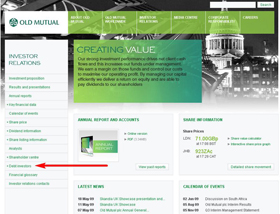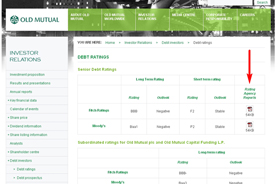For many companies, Investor Relations is all about the stockholders. This focus is not surprising. Regulatory filings are generally focused around company stock, and there tend to be more stock investors than bond investors ringing the phones of the IR group.
Stock investors tend to be a more fickle bunch, especially retail investors looking for quick trading profits. Such investors are actually the least likely to ever even see your IR page, let alone examine it carefully. However, longer-term investors, and certainly institutional investors will want to devour as much information as possible about the company and its operations. Often, this research is a quest for information that others don’t realize yet, or that is being misinterpreted by the markets.
If others don’t realize just how strong the company is, or how quickly it will recover from its recent missteps, then buying now in order to wait for others to finally see the more obvious data come in can result in a tidy profit. However, finding such information means wading deep into documents, filings, and transcripts in search of uncovered stones, since just about everyone will be aware of more obvious elements like P/E ratios and earnings statements.
The quest of many IR departments is thus to fulfill the basic legal and regulatory requirements for the majority of visitors, as well as provide data and information to be absorbed by media, analysts, and those investors and potential investors who want ever more data.
What about Debt Investors?
For many years now, the IR departments of many companies have simply outsourced their bond-based Investor Relations to the various debt ratings agencies like Moody’s, Standard and Poors, and Fitch. However, with the financial meltdown came the uncomfortable realization that the ratings agencies don’t always know best.
Still, most debt investors at least start their investment research with the bond ratings provided by the rating firms. Yet, many IR websites don’t even acknowledge the company has bonds outstanding, let alone provide ratings or research. This may be a mistake, especially for companies with solid ratings.
Consider the income investor looking for, perhaps, a dividend paying stock. Maybe, for whatever reason, he decides that while he likes the company, the stock just isn’t right for him right now. But, his attention is drawn to the Debt or Bonds link on the IR site and maybe, he likes what he sees there. Purchasing those bonds would surely keep the company on the radar of such an investor and may result in a share purchase later, particularly if the stock is unfairly beaten down by surrounding events.
Likewise, a potential investor who is on the fence about a stock purchase may have already devoured all of the information provided, but still hasn’t been able to come to a solid conclusion. Upon clicking on the Debt links in the sidebar, the investor notices that the company’s outstanding bond issues are all highly rated. Even better, he notes that the bonds are all issued at low rates suggesting both the consensus opinion that the company is sound, and that it can use the leverage provided by the capital markets if the opportunity arises. Combined with the other “pluses” from the rest of the time spent on the IR site, those bond ratings turn the potential investor into a shareholder.
Providing Bond Information
Certainly, a company’s debt information can confuse an otherwise clean and solid Investor Relations web page. That is why it is often wise to create a sub-site for debt ratings and other bond information.
Old Mutual provides just such information in a clean and classic fashion. On an investor relations site filled with information, a single link is displayed. This serves both to avoid complicating the investment information sought by equity investors and shareholders, and by being the same kind of link in the menu as all the others, it also conveys that debt information is regarded as just as important by the company as the other similarly linked items.
Choosing to title the menu link as “Debt Investors” allows the company to sidestep any negative connotation regarding its outstanding bonds. This section, the title suggests, will not be an excuse for having excess debt, but rather a way to ensure that investors in such products are properly informed.
Once clicked, the bond investor finds themselves on an internal landing page where at-a-glance information is provided in the form of a table. An investor, whether equity or debt can peruse the outstanding issues and their ratings. If further details are desired, links are provided both in the form of sub-menus. Each issue is also clickable resulting in the user being shown the offering circular for that particular issue.
The company also provides its overall ratings, and links to the full company report from the rating agencies. This ensures that the prospective investor will go from here to impartial third-party research rather than a Google search sending them to whatever commentator happens to have chosen the right keywords for their search engine optimization efforts.
Old Mutual goes a step further by providing a dedicated Debt investor contact for users. Any savvy debt investor knows that their is a world of difference between an equity investment and buying a company’s bonds, and it must be reassuring to see that the company understands that as well.
Investor Relations Best Practices
Consider incorporating debt ratings and bond information on your investor relations website as well. Take care to ensure that the additional details do not add to the overall complexity of the IR webpages by segregating them under their own easy to find link or menu option. However, don’t make the mistake of “burying” debt information under other seemingly related links. Bond data is not so common on IR sites yet that a bond investor will look very far to find it. Two levels deep in the menu structure virtually guarantees the user will have left the site before finding what they are looking for.
Regulatorily speaking, providing links to companies like the rating agencies are some of the safest links an investor page can make, as they are already widely regarded as impartial third-party links. However, linking to only one agency with the highest rating would be a mistake. If possible, provide links to all three major rating agencies, in addition to any other provided links.
The investor who finds what they are looking for on your official IR site will find little incentive to go elsewhere, and with the current environment that rewards company criticism over praise, that may be half the battle.
Lucy is Editor at Corporate Eye

